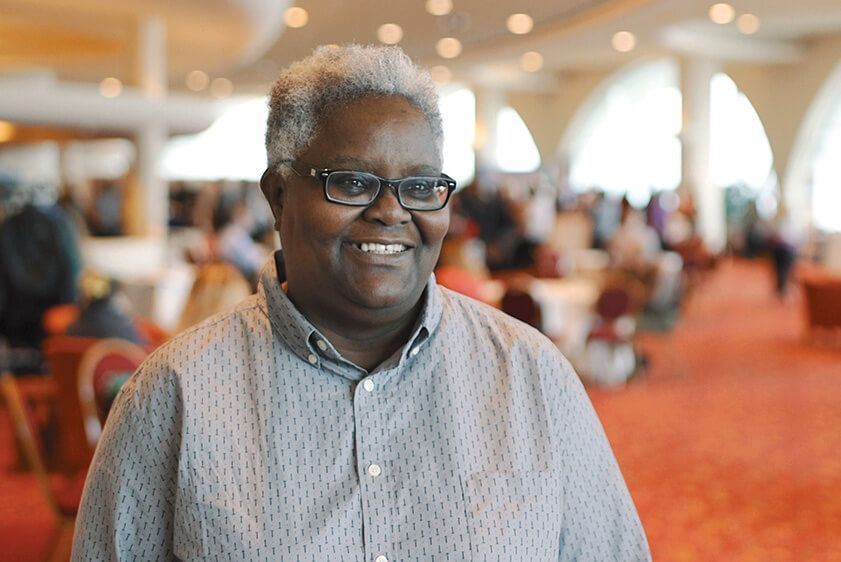A tip from a friend brought Alnisa Allgood to Madison in 1991. When she arrived, she had no place to live and no clue how long she would stay. She also had no idea she would become the founder of UW–Madison’s first LGBT campus center just a year later.
“We filled archives with the Wisconsin Historical Society during the first few years of the center. Creating history is important,” she says.
Allgood shares fond memories of her first few moments in the city after riding along with her friend, Bob, all the way from Penn State, where she had studied chemical engineering and administration of justice. At that time, Allgood’s affinity for traveling had relocated her from state to state for a large portion of her adult life, and she found herself faced with options to live in Wisconsin, North Carolina, or Arizona.
“A friend says, ‘I’d really think you’d like Madison,’ ” Allgood says, noting, for her, that the best cities to live in are college towns because of the resources in them — and Madison had that. Bob was interested and willing to pick up and go with her when she moved again, so the two of them hitched a ride to the great state of Wisconsin.
“That first summer was just gorgeous. There was water everywhere. We would just sit on Lake Monona [or] on the Terrace,” Allgood recalls.
She says the first thing they did was attend a meeting on University Avenue for the UW’s Ten Percent Society, an organization for gay students. Allgood says the group was welcoming — so welcoming, in fact, that its members allowed her and Bob to sleep in the organization’s house. The university housed student organizations like the Ten Percent Society, the Campus Women’s Center, and the Multicultural Student Center.
“[The Ten Percent Society was] the LGBT organization that made the most money in town,” Allgood says.
She made many friends within the queer community in Madison and got to know some of the other organizations while attending some of the city’s social attractions for people who identify as queer. Allgood remembers attending informal meetings for the Gay and Lesbian Ethnic Minority Association (GLEMA) at the Barber’s Closet, a bar in Hotel Washington, which had been a cultural epicenter for the Madison LGBTQ+ community before it burned down in 1996.
Allgood says she never got into the drinking culture of Madison, but she loved going out to dance. She did find herself becoming more involved with the Ten Percent Society, which wanted a gay and lesbian center on campus.
“They felt that because the [UW System] Board of Regents created a Multicultural Student Center, the board of regents should give them a center,” Allgood says.
She spent about two or three weeks going through the Ten Percent Society’s historical files. There was a clear path on how to open a center that did not involve the board of regents, so she went for it. After getting a variety of LGBTQ+ organizations involved, looking for donations, and applying for grants, she went to the Associated Students of Madison.
“I think we got almost everything that we asked for,” Allgood says — but not quite everything. “There was no space on campus they were going to give us that was big enough for what we wanted,” she says.
She wanted a space to hold meetings where students could work as well as have a lending library. She also wanted some little things that she felt were important for the center — for example, a couch.
Although the university told them there was no space on campus to have the center, the organizers eventually found a suitable location off campus near Capitol Centre Court Apartments on West Dayton Street. The center they created here met all of the group’s needs at the time. It had a good staff, computers, and the ability to rearrange the space to offer more privacy. And being off of campus, too, created additional privacy — an important feature at the time.
“It was kind of nice because it was still the time where students were kind of fearful of coming out,” Allgood says.
The organizers of the center established boundaries where that fear could be alleviated. Professors were encouraged to include LGBTQ+ history and studies in their curriculum and offer students extra credit, which gave students who were not out or questioning an excuse to go to the center.
“It actually worked twofold because it gave straight people a reason to be in the building,” Allgood says.
The center also set a precedent for revolutionary programming. Allgood hired an assistant director. Together they created email lists of students and a small lending-library solution. The email list and promotional strategies increased awareness of the center’s programming significantly. They began offering support groups for questioning students who were not out, as well as speaker events.
“We started working with our allies like the Campus Women’s Center and the Multicultural Center,” Allgood says.
Rather than only inviting a host of white, gay, male speakers, as many groups did, she says the center focused on women and queer people of color.
With this approach, the center has seen growth over the years. Although Allgood went on to pursue other ventures in her technology career, the center — which changed its name to the Gender and Sexuality Campus Center in 2018 and is now located in the Red Gym — has become a campus and community staple.
Allgood now focuses on changing the face of entrepreneurship and enhancing the region’s capacity for social good as the founder and executive director of Collaboration for Good, Inc., which runs programs such as the Social Good Summit and Nonprofit Draft Day.
While she continues to do good for the community, her spontaneous journey to Madison has left a legacy: creating a welcoming space for queer students.










